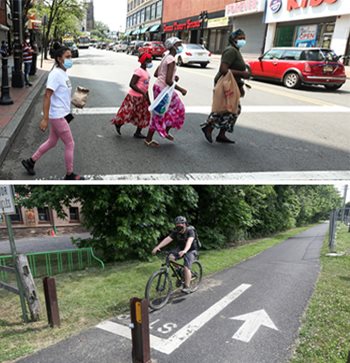 Improving “active transportation”—people’s ability to walk and bike—offers economic, health and environmental benefits to the region, according to a new paper published by the NJTPA.
Improving “active transportation”—people’s ability to walk and bike—offers economic, health and environmental benefits to the region, according to a new paper published by the NJTPA.
The NJTPA is publishing a series of background papers to inform its update of the region’s Long Range Transportation Plan, Plan 2050: Transportation, People, Opportunity, which is set to be adopted in fall 2021. The active transportation paper is the first to be published and can be viewed here.
The COVID-19 pandemic has added to the importance of walking and biking as a means of exercise, recreation and safe mobility, the paper notes. Increasingly, towns are adopting and implementing “complete streets” policies to better accommodate walking and biking and meet the needs of all travelers, young and old.
“The concept of ‘complete streets’ that meet the needs of everyone is no longer an academic planning vision but rather a main street reality,” said NJTPA Chair Kathryn DeFillippo, a Morris County Freeholder. “We've seen towns quickly transform and use sidewalks and streets in creative ways as never seen before.”
The paper notes that while automobiles remain essential for travel in the region—especially given the legacy of past auto-oriented planning and development practices—the NJTPA and its partner agencies seek to balance investments so that walking and biking are also encouraged and enabled.
It says expanding active transportation provides important benefits, including:
- supporting economically vital mobility, particularly for young people, elderly, low-income people and otherswithout vehicles;
- promoting healthy lifestyles to prevent chronic illnesses, particularly obesity;
- realizing a cleaner environment, including reducing 40 percent of greenhouse gas emissions and other pollutants generated by transportation; and
- enhancing quality of life and strengthened communities.
A key challenge identified is the need for improved infrastructure. While New Jersey has a network of more than 214 miles of off-road paths shared by bicyclists and pedestrians, expansion is needed to accommodate growing use and increasing population. For on-road facilities, network gaps—such as a missing section of sidewalk or a disjointed bicycle network—can pose a safety hazard and discourage people from cycling or walking.
Addressing safety must be a top priority, according to the paper. The state’s pedestrian fatality rate is nearly double the national average. Crashes are overrepresented on state and county facilities, among the busiest roads in the region, many of which lack adequate pedestrian and bike infrastructure.
Among the strategies identified for improving active transportation are:
- Extending sidewalks and adding safety features such as pedestrian countdown timers, high-visibility crosswalks and curb extensions.
- “Calming” streets, particularly in downtown or residential areas, by implementing road diets, decreased lane widths, speed humps and other measures.
- Improving the bicycle network with continuous routes consisting of multi-use trails, bicycle lanes, roads with ample shoulders or shared lanes.
- Improving access to transit through transit-oriented development, more bicycle parking, upgrading bus stops and improved lighting.
- Observing the federal Americans with Disabilities Act to accommodate those with mobility limitations and enhance access to destinations.
Several NJTPA programs support these and other strategies in cooperation with city and county subregions. In particular, NJTPA’s Local Safety and High Risk Rural Roads Programs provide funding on a competitive basis for multimodal safety treatments on local roads and at intersections. Also focusing on the local level, the Planning for Emerging Centers Program provides technical support to municipalities to create more sustainable, transit-supportive and walkable communities.
NJTPA study programs also directly address active transportation. Examples cited in the paper include: the Morris Canal Greenway Corridor Study, which identified strategies to realize a continuous greenway stretching 111 miles across the region; the JC Walks Jersey City Pedestrian Enhancement Plan, which included walkability workshops and demonstration projects; and the City of Passaic Main Avenue Corridor Improvements study investigating concepts for implementing a complete streets plan in the study area.
The NJTPA also works with numerous municipalities and the region’s eight Transportation Management Associations on the Street Smart NJ Pedestrian Safety Campaign to raise awareness of pedestrians, bicyclist and drivers about traffic regulations and safe travel behaviors. The NJTPA also actively coordinates with NJDOT and the New Jersey Division of Highway Traffic Safety on conducting safety audits around the region and developing and implementing New Jersey’s Strategic Highway Safety Plan.
To improve active transportation over the long term, the paper recommends the NJTPA: give priority to active transportation where possible in NJTPA plans and programs; explore creating an Active Transportation Plan for the region; promote education and public participation regarding active transportation; improve regional data; and expand available funding.